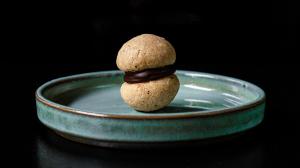Crumbly orbs of nuts, butter and sugar, each representing half of a kiss, with the chocolate uniting and sealing their love. Tiny “baci di dama” or “lady’s kisses” take long to make but are so satisfying and exquisite to eat and, like toasted hazelnuts, they don’t last long !
The “baci di dama” are biscuits originating in Piedmont, where they were born a century ago. They are so called because they are composed of two cookie shells joined by chocolate, that recall two lips intent on kissing.
Legend has it that these sweets were born from the imagination of a cook of the House of Savoy in the autumn of 1852 at the request of Victor Emmanuel II to taste a new dessert. The product met with approval and has since been served on royal tables in Italy and, later, all over Europe.
After several tries with equal weights of flour, hazelnut powder, sugar and butter and also freezing the dough balls before baking them, the cookies spread out and ended up as flat cookies but were a delicious mistake.
I finally doubled the flour quantity, as compared to the quantities of the hazelnut powder, sugar and butter and it was a success. The cookies retained their domed shapes and were crumbly, crunchy and tasty.
Here are some important points to remember :
- the dough will be rather dry, so add some water or hazelnut liqueur to bind it and press it together into a smooth ball and let it rest and chill in the refrigerator before shaping into little balls, which are tiny (about 2 cm in diameter and only weigh about 5 grams each) and they must be that small because if they were larger, they would require more baking time and thus inevitably flatten out.
- freezing the dough is also necessary step, otherwise they will flatten while baking (first at 150°C and then at 120°C).
- for the chocolate filling, you must melt the chocolate but then wait for it to get firmer again (I waited 15-30 minutes) so that you can delicately spoon some chocolate onto each of the two half-shells, on the flat side, delicately balanced on a cooling rack, then wait again before assembling the two chocolate covered half domes, so that you end up with a thicker chocolate filling that won’t simply be squeezed out onto the sides when assembled.
I will not lie to you, they are time-consuming to make and disappear quickly too, because they’re such a delight ! … :)















